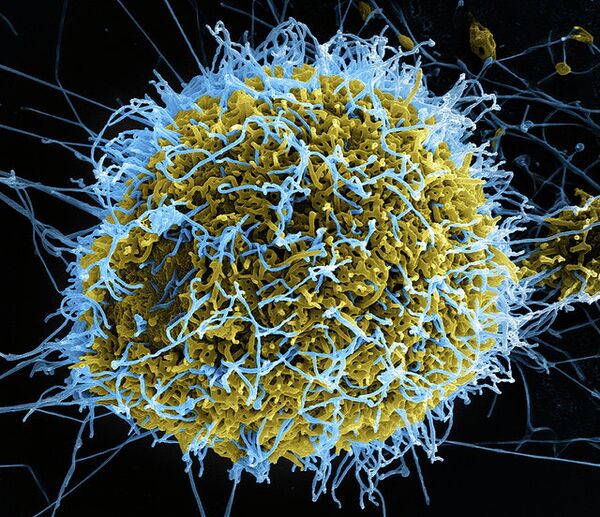MOSCOW, October 17 (RIA Novosti) - World Health Organization (WHO) has announced that the Ebola virus in Senegal has stopped spreading.
Ebola hemorrhagic fever (EHF) is a severe, acute and highly contagious viral infection marked by a high mortality rate and the emergence of hemorrhagic syndrome (a tendency toward skin hemorrhages and mucus membrane bleeding).
The fatality rate of the disease can reach 90 percent. Outbreaks of Ebola fever usually occur in Central and West African remote villages near rainforests.
The Ebola virus first emerged in 1976 simultaneously in two regions – in Sudan's town of Nzara and the village of Yambuku in the democratic Republic of Congo (Zaire). In the latter case, the village was adjacent to the Ebola River, hence the name.
The Ebola virus belongs to the Filoviridae group that also includes Marburgvirus and Cuevavirus. There are five subtypes of the Ebola virus: Bundibugyo ebolavirus (BDBV), Zaire ebolavirus (EBOV), Reston ebolavirus (RESTV), Sudan ebolavirus (SUDV), and Taï Forest ebolavirus (TAFV). Unlike the Reston and Taï Forest subtypes, the Bundibugyo, Zaire and Sudan subtypes were linked to large outbreaks of Ebola fever in Africa. The Reston ebolavirus, discovered in the Philippines and China, can affect humans, however, no cases of fever or deaths among people have been recorded in those areas so far.
The virus occurs naturally in rodents living near areas inhabited by people. An infected person poses a threat for those around him. The Ebola virus spreads through damaged skin or mucosa in close contact. Secondary and tertiary infections have been recorded mainly among hospital staff. Healthcare workers often contract the disease when they work with Ebola patients. Patients remain contagious for about three weeks. The infection can also spread through poorly sterilized needles and other medical instruments.
People can come in contact with the disease during funeral rites, which can also spread the virus. The disease may also be transmitted through contact with objects contaminated by an infected person.
People can contract the virus through close contact with the blood and bodily fluids of infected animals. There have been cases documented in Africa of people being infected when dealing with dead or sick animals that were infected, including chimpanzees, gorillas, bats, mice, monkeys, antelopes and other animals in the rainforest.
Typically, no visible signs can be observed at the point the infection enters the body. The incubation period (the interval between catching the disease and the appearance of the symptoms) varies from two to 21 days.
Ebola disease is accompanied by a sudden fever, muscle pain, headaches and a sore throat followed by vomiting, diarrhea, rash, malfunctioning of the kidneys and liver, and, in some cases, internal and external bleeding. An infected person usually dies during the second week of the illness is due to bleeding and shock.
Laboratory tests reveal low levels of white blood cells and platelets along with increased liver ferment levels.
People remain carriers of the infection as long as their blood and bodily fluids contain the virus.
When tested, seven percent of the population in the endemic areas (affected by the infection) appeared to have Ebola virus antibodies, which may suggest a mild or even symptomless occurrence of the disease that can remain undetected.
he Ebola virus can only be accurately diagnosed in laboratories through various tests.
Severe cases require intensive support therapy. Patients often suffer from dehydration and require intravenous injections of fluids or oral rehydration using electrolyte solutions. Currently, no effective treatment methods are available.
The Ebola fever 2014 outbreak was caused by the Zaire ebolavirus.
The current West African outbreak is the most massive and complicated Ebola fever outbreak since the virus was discovered in 1976. The first cases of the disease were recorded in March 2014. The outbreak started in Guinea and spread to Sierra Leone and Liberia over land borders and also by air to Nigeria (one passenger) and by surface transport to Senegal (also one passenger).
According to the October 17 WHO data, a total of 9,216 cases of Ebola infection have been confirmed, with 4,555 deaths registered.
According WHO, 1,519 cases of Ebola fever were recorded in Guinea, including 862 deaths. The breakdown for other regional countries is as follows:
Liberia: 4,262 people, including 2,484 deaths;
Sierra Leone: 3,410 people, including 1,200 deaths;
Nigeria: 20 cases, including eight deaths;
Senegal: One reported case.
The latest update shows that two nurses at a Dallas hospital have contracted the virus from a Liberian who died of Ebola fever in the United States.
On September 25, 2014, Catholic Priest Manuel Garcia Viejo, who had contracted the disease in Sierra Leone, died in Spain, where he was treated at the Carlos III Hospital in Madrid. On August 12, Priest Miguel Pajares, who contracted the Ebola fever in Liberia and who was transported to Spain for treatment, died at the same hospital. On October 6, the media reported that nurse Theresa Romero, who cared for Priest Manuel Garcia Viejo, had tested positive for the deadly virus. To obtain the most authentic updates, WHO is forced to adjust official data by multiplying these statistics by 1.5 for Guinea, by two for Sierra Leone and by 2.5 for Liberia, said WHO Assistant Director General Bruce Aylward.
WHO experts believe the VSV-EBOV and ChAd-EBO vaccines, developed by GlaxoSmithKline in the United Kingdom, are the most promising medications for treating the Ebola fever. These vaccines are based on the vesicular stomatitis virus mixed with the Ebola gene and the chimpanzee adenovirus gene.
In Russia, the Novosibirsk-based Vector State Center of Virology and Biotechnology is also developing a vaccine against the Ebola virus and is currently testing several types of this vaccine.

